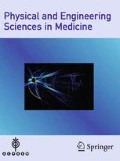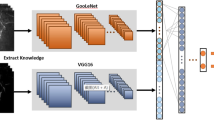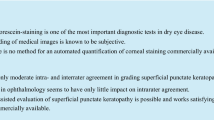Abstract
The purpose of this study is to evaluate the accuracy of two methods in diagnosis of fungal keratitis, whereby one method is automatic hyphae detection based on images recognition and the other method is corneal smear. We evaluate the sensitivity and specificity of the method in diagnosis of fungal keratitis, which is automatic hyphae detection based on image recognition. We analyze the consistency of clinical symptoms and the density of hyphae, and perform quantification using the method of automatic hyphae detection based on image recognition. In our study, 56 cases with fungal keratitis (just single eye) and 23 cases with bacterial keratitis were included. All cases underwent the routine inspection of slit lamp biomicroscopy, corneal smear examination, microorganism culture and the assessment of in vivo confocal microscopy images before starting medical treatment. Then, we recognize the hyphae images of in vivo confocal microscopy by using automatic hyphae detection based on image recognition to evaluate its sensitivity and specificity and compare with the method of corneal smear. The next step is to use the index of density to assess the severity of infection, and then find the correlation with the patients’ clinical symptoms and evaluate consistency between them. The accuracy of this technology was superior to corneal smear examination (p < 0.05). The sensitivity of the technology of automatic hyphae detection of image recognition was 89.29%, and the specificity was 95.65%. The area under the ROC curve was 0.946. The correlation coefficient between the grading of the severity in the fungal keratitis by the automatic hyphae detection based on image recognition and the clinical grading is 0.87. The technology of automatic hyphae detection based on image recognition was with high sensitivity and specificity, able to identify fungal keratitis, which is better than the method of corneal smear examination. This technology has the advantages when compared with the conventional artificial identification of confocal microscope corneal images, of being accurate, stable and does not rely on human expertise. It was the most useful to the medical experts who are not familiar with fungal keratitis. The technology of automatic hyphae detection based on image recognition can quantify the hyphae density and grade this property. Being noninvasive, it can provide an evaluation criterion to fungal keratitis in a timely, accurate, objective and quantitative manner.




Similar content being viewed by others
References
Tarabishy AB (2008) MyD88 regulation of Fusarium keratitis is dependent on TLR4 and IL-1R1 but not TLR2. J Immunol 181(1):593–600
Chin GN, Hyndiuk RA, Kwasny GP (1975) Keratomycosis in Wisconsin. Am J Ophthalmol 79(1):121–125
Xie L (2006) Spectrum of fungal keratitis in north China. Chin J Ophthalmol 113(11):1943–1948
Liu J, Wong D, Lim J, Li H, Tan N, Zhang Z, WongT, Lavanya R (2009) ARGALI: an automatic cup-to-disc ratio measurement system for glaucoma analysis using level-set image processing. In: Proceedings of 13th international conference on biomedical engineering, vol 23. Springer, Berlin, pp 559–562
Narasimha-lyer H, Can A, Roysam B, Stewart C, Tanenbaum H, Majerovics A, Singh H (2006) Robust detection and classification of longitudinal changes in color retinal fundus images for monitoring diabetic retinopathy. IEEE Trans Biomed Eng 53(6):1084–1098
Singh A, Dutta MK, Partha Sarathi M, Uher V, Burget R (2015) Image processing based automatic diagnosis of glaucoma using wavelet features of segmented optic disc from fundus image. Comput Methods Programs Biomed 124:108–120
Huang W, Chan KL, Li H, Lim JH, Liu J, Wong TY (2011) A computer assisted method for nuclear cataract grading from slit-lamp images using ranking. IEEE Trans Med Imaging 30(1):94–107
Qiu Q, liu Z, Zhao Y, Wei D, Wu X (2016) Automatic detecting cornea fungi based on texture analysis. In: 2016 IEEE international conference on smart cloud, New York, pp 214–217
Wong KKL, Chu WCW (2015) Ethics policies and procedures in imaging and interventional radiology. Australas Phys Eng Sci Med 38(2):375–376
Wong KKL, Hui SCN (2015) Ethical principles and standards for the conduct of biomedical research and publication. Australas Phys Eng Sci Med 38(3):377–380
Xie X, Mirmehdi M (2008) A galaxy of texture features. In: Xie X, Mirmehdi M (eds) Handbook of texture analysis. Imperial College Press, London, pp 375–406
Riaz F, Hassan A, Rehman S, Qamar U (2013) Texture classification using rotation-and scale-invariant gabor texture features. IEEE Signal Proc Lett 20:607–610
Hafiane A, Palaniappan K, Seetharaman G (2015) Joint adaptive median binary patterns for texture classification. Pattern Recogn 48:2609–2620
Quinlan JR (1986) Induction on decision tree. Mach Learn 1(1):81–106
Dudani SA (1976) The distance-weighted k-nearest-neighbor rule. IEEE Trans Systems Man Cybern 6(4):325–327
Andrew C (2000) Applied logistic regression. Technometrics 34(3):358–359
Davis LS, Johns SA, Aggarwal JK (1979) Texture analysis using generalized cooccurrence matrices. IEEE Trans Pattern Anal Mach Learn 1(3):251–259
Adankon MM, Cheriet M (2009) Support vector machine. In: International conference on intelligent networks and intelligent systems
Chang CC, Lin CJ (2001) LIBSVM: a library for support vector machines. Am Trans Intell Syst Technol 2(3):389–396
Vaddavalli PK, Garg P, Sharma S, Sangwan VS, Rao GN, Thomas R (2011) Role of in vivo confocal microscopy in the diagnosis of fungal and acanthamoeba keratitis. Ophthalmology 118(1):29–35
An N, Wang Y, Liu X, Zhu J, Zhu X, Wu J (2010) Identification of pathogenic species of fungal keratitis by PCR. Rec Adv Ophthalmol 30(11):1017–1020
Li SW, Gebhardt BM, Shi WY, Beuerman RW, Kaufman SC, Kaufman HE, Xie LX (2001) Differentiation of fungal species in fungal keratitis by confocal microscopy. Chin Ophthalmol Res 19(5):389–392
Zhang W, Yang H, Jiang L, Han L, Wang L (2010) Use of potassium hydroxide, Giemsa and calcofluor white staining techniques in the microscopic evaluation of corneal scrapings for diagnosis of fungal keratitis. J Int Med Res 38(6):1961–1967
Chidambaram JD, Prajna NV, Larke NL, Palepu S et al (2016) Prospective study of the diagnostic accuracy of the in vivo laser scanning confocal microscope for severe microbial keratitis. Ophthalmology 123(11):2285–2293
Xie LX, Li SW, Shi WY, Han DS (1999) Application of in vivo confocal microscope in clinical diagnosis of fungal keratitis. Chin J Ophthalmol 35(1):7–9
Winchester K, Mathers WD, Sutphin JE (1997) Diagnosis of Aspergillus keratitis in vivo with in vivo confocal microscopy. Cornea 16:27–31
Zeng Q, Dong X, Shi W et al (2004) The role of fungal spore adhesion and matrix metalloproteinase in fungal keratitis. Chin J Ophthalmol 40:774–776
Chidambaram JD et al (2017) In vivo confocal microscopy appearance of Fusarium and Aspergillus species in fungal keratitis. Br J Ophthalmol 101(8):1119–1123
Author information
Authors and Affiliations
Corresponding author
Ethics declarations
Conflict of interest
The authors declare no conflict of interests.
Ethical approval
Ethical approval was obtained by the institutional review board of Second people’s Hospital of Jinan, and all patients have given their consent in this participation. All procedures performed in studies involving human participants were in accordance with the ethical standards of the institutional and/or national research committee and with the 1964 Helsinki declaration.
Rights and permissions
About this article
Cite this article
Wu, X., Tao, Y., Qiu, Q. et al. Application of image recognition-based automatic hyphae detection in fungal keratitis. Australas Phys Eng Sci Med 41, 95–103 (2018). https://doi.org/10.1007/s13246-017-0613-8
Received:
Accepted:
Published:
Issue Date:
DOI: https://doi.org/10.1007/s13246-017-0613-8




